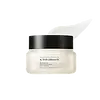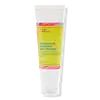What's inside
What's inside
 Key Ingredients
Key Ingredients

 Benefits
Benefits

 Concerns
Concerns

 Ingredients Side-by-side
Ingredients Side-by-side

Centella Asiatica Leaf Water
Skin ConditioningButylene Glycol
HumectantWater
Skin ConditioningCetyl Alcohol
EmollientButyrospermum Parkii Butter
Skin ConditioningStearyl Alcohol
Emollient1,2-Hexanediol
Skin ConditioningGlyceryl Stearate
EmollientButylene Glycol Dicaprylate/Dicaprate
EmollientMacadamia Integrifolia Seed Oil
Skin ConditioningNiacinamide
SmoothingPolyglyceryl-4 Caprate
EmulsifyingPhenyl Trimethicone
Skin ConditioningGlycerin
HumectantAmmonium Acryloyldimethyltaurate/Vp Copolymer
Isoamyl Laurate
EmollientCaprylic/Capric Glycerides
EmollientCaprylic/Capric Triglyceride
MaskingHydroxyacetophenone
AntioxidantMyristyl Alcohol
EmollientHydrogenated Lecithin
EmulsifyingArginine
MaskingCarbomer
Emulsion StabilisingHeptyl Undecylenate
EmollientPropanediol
SolventArtemisia Capillaris Extract
Octyldodecanol
EmollientCeramide NP
Skin ConditioningSodium Hyaluronate
HumectantPalmitic Acid
EmollientScutellaria Baicalensis Root Extract
AstringentCoptis Chinensis Root Extract
AntioxidantAstragalus Membranaceus Root Extract
EmollientPhellodendron Amurense Bark Extract
Skin ConditioningLauryl Alcohol
EmollientStearic Acid
CleansingAdenosine
Skin ConditioningPyrus Communis Fruit Extract
Skin ConditioningOlea Europaea Fruit Extract
BleachingRosa Damascena Flower Water
MaskingPhytosterols
Skin ConditioningIris Florentina Root Extract
MaskingOleic Acid
EmollientCucumis Melo Fruit Extract
Skin ConditioningHedera Helix Leaf/Stem Extract
AntimicrobialCandida Bombicola/Glucose/Methyl Rapeseedate Ferment
AntimicrobialCetearyl Alcohol
EmollientCaprylyl Glycol
EmollientPolyglyceryl-3 Methylglucose Distearate
EmulsifyingCamellia Sinensis Leaf Extract
AntimicrobialOryza Sativa Germ Oil
EmollientCocos Nucifera Oil
MaskingChamomilla Recutita Extract
Skin ConditioningMyristic Acid
CleansingPentylene Glycol
Skin ConditioningFicus Carica Fruit Extract
HumectantMorus Alba Fruit Extract
AntioxidantPunica Granatum Fruit Extract
AntioxidantGinkgo Biloba Nut Extract
Skin ConditioningCalendula Officinalis Extract
Skin ConditioningSparassis Crispa Extract
Emulsion StabilisingDaucus Carota Sativa Root Extract
Skin ConditioningGlycine Soja Germ Extract
EmollientCamellia Japonica Flower Extract
EmollientMadecassoside
AntioxidantIlex Paraguariensis Leaf Extract
PerfumingCorchorus Olitorius Leaf Extract
Skin ConditioningUndaria Pinnatifida Extract
Skin ConditioningBorago Officinalis Extract
EmollientZingiber Officinale Root Extract
MaskingIllicium Verum Fruit Extract
PerfumingOriganum Vulgare Leaf Extract
Skin ConditioningGeranium Maculatum Extract
TonicChrysanthellum Indicum Extract
Skin ConditioningChamaecyparis Obtusa Leaf Extract
Skin ConditioningLaminaria Digitata Extract
Skin ProtectingSalix Alba Bark Extract
AstringentLactobacillus/Soybean Ferment Extract
Skin ConditioningPortulaca Oleracea Extract
Skin ConditioningSoluble Collagen
HumectantCinnamomum Cassia Bark Extract
MaskingHydrolyzed Collagen
EmollientAtelocollagen
Skin ConditioningAcetyl Hexapeptide-8
HumectantPalmitoyl Pentapeptide-4
Skin ConditioningCentella Asiatica Leaf Water, Butylene Glycol, Water, Cetyl Alcohol, Butyrospermum Parkii Butter, Stearyl Alcohol, 1,2-Hexanediol, Glyceryl Stearate, Butylene Glycol Dicaprylate/Dicaprate, Macadamia Integrifolia Seed Oil, Niacinamide, Polyglyceryl-4 Caprate, Phenyl Trimethicone, Glycerin, Ammonium Acryloyldimethyltaurate/Vp Copolymer, Isoamyl Laurate, Caprylic/Capric Glycerides, Caprylic/Capric Triglyceride, Hydroxyacetophenone, Myristyl Alcohol, Hydrogenated Lecithin, Arginine, Carbomer, Heptyl Undecylenate, Propanediol, Artemisia Capillaris Extract, Octyldodecanol, Ceramide NP, Sodium Hyaluronate, Palmitic Acid, Scutellaria Baicalensis Root Extract, Coptis Chinensis Root Extract, Astragalus Membranaceus Root Extract, Phellodendron Amurense Bark Extract, Lauryl Alcohol, Stearic Acid, Adenosine, Pyrus Communis Fruit Extract, Olea Europaea Fruit Extract, Rosa Damascena Flower Water, Phytosterols, Iris Florentina Root Extract, Oleic Acid, Cucumis Melo Fruit Extract, Hedera Helix Leaf/Stem Extract, Candida Bombicola/Glucose/Methyl Rapeseedate Ferment, Cetearyl Alcohol, Caprylyl Glycol, Polyglyceryl-3 Methylglucose Distearate, Camellia Sinensis Leaf Extract, Oryza Sativa Germ Oil, Cocos Nucifera Oil, Chamomilla Recutita Extract, Myristic Acid, Pentylene Glycol, Ficus Carica Fruit Extract, Morus Alba Fruit Extract, Punica Granatum Fruit Extract, Ginkgo Biloba Nut Extract, Calendula Officinalis Extract, Sparassis Crispa Extract, Daucus Carota Sativa Root Extract, Glycine Soja Germ Extract, Camellia Japonica Flower Extract, Madecassoside, Ilex Paraguariensis Leaf Extract, Corchorus Olitorius Leaf Extract, Undaria Pinnatifida Extract, Borago Officinalis Extract, Zingiber Officinale Root Extract, Illicium Verum Fruit Extract, Origanum Vulgare Leaf Extract, Geranium Maculatum Extract, Chrysanthellum Indicum Extract, Chamaecyparis Obtusa Leaf Extract, Laminaria Digitata Extract, Salix Alba Bark Extract, Lactobacillus/Soybean Ferment Extract, Portulaca Oleracea Extract, Soluble Collagen, Cinnamomum Cassia Bark Extract, Hydrolyzed Collagen, Atelocollagen, Acetyl Hexapeptide-8, Palmitoyl Pentapeptide-4
Water
Skin ConditioningGlycerin
HumectantAspergillus Ferment
Skin ConditioningPropanediol
SolventCetearyl Alcohol
EmollientSaccharomyces Ferment
Skin ConditioningCetyl Tranexamate Mesylate
Skin ConditioningGlyceryl Stearate
EmollientNiacinamide
SmoothingBehentrimonium Methosulfate
Simmondsia Chinensis Seed Oil
EmollientPanthenol
Skin ConditioningPalmitic Acid
EmollientCaprylyl Glyceryl Ether
CleansingCapryloyl Salicylic Acid
ExfoliatingStearic Acid
CleansingArginine
MaskingCaprylhydroxamic Acid
Sodium Hydroxide
BufferingWater, Glycerin, Aspergillus Ferment, Propanediol, Cetearyl Alcohol, Saccharomyces Ferment, Cetyl Tranexamate Mesylate, Glyceryl Stearate, Niacinamide, Behentrimonium Methosulfate, Simmondsia Chinensis Seed Oil, Panthenol, Palmitic Acid, Caprylyl Glyceryl Ether, Capryloyl Salicylic Acid, Stearic Acid, Arginine, Caprylhydroxamic Acid, Sodium Hydroxide
 Reviews
Reviews

Ingredients Explained
These ingredients are found in both products.
Ingredients higher up in an ingredient list are typically present in a larger amount.
Arginine is an amino acid that is important for human development. Your body uses is it to produce hair keratin and skin collagen.
As a cosmetic ingredient, Arginine has antioxidant properties and can also help repair damaged skin. This ingredient is derived either synthetically or from animals.
Arginine isn't fungal acne safe when used in the presence of other lipids (fats, fatty acids, oils, esters, etc). Oils and fats occur naturally within the skin, so take caution when using Arginine if you're prone to fungal acne.
Learn more about ArginineCetearyl alcohol is a mixture of two fatty alcohols: cetyl alcohol and stearyl alcohol. It is mainly used as an emulsifier. Emulsifiers help prevent the separation of oils and products. Due to its composition, it can also be used to thicken a product or help create foam.
Cetearyl alcohol is an emollient. Emollients help soothe and hydrate the skin by trapping moisture.
Studies show Cetearyl alcohol is non-toxic and non-irritating. The FDA allows products labeled "alcohol-free" to have fatty alcohols.
This ingredient is usually derived from plant oils such as palm, vegetable, or coconut oils. There is debate on whether this ingredient will cause acne.
Due to the fatty acid base, this ingredient may not be Malassezia folliculitis safe.
Learn more about Cetearyl AlcoholGlycerin is already naturally found in your skin. It helps moisturize and protect your skin.
A study from 2016 found glycerin to be more effective as a humectant than AHAs and hyaluronic acid.
As a humectant, it helps the skin stay hydrated by pulling moisture to your skin. The low molecular weight of glycerin allows it to pull moisture into the deeper layers of your skin.
Hydrated skin improves your skin barrier; Your skin barrier helps protect against irritants and bacteria.
Glycerin has also been found to have antimicrobial and antiviral properties. Due to these properties, glycerin is often used in wound and burn treatments.
In cosmetics, glycerin is usually derived from plants such as soybean or palm. However, it can also be sourced from animals, such as tallow or animal fat.
This ingredient is organic, colorless, odorless, and non-toxic.
Glycerin is the name for this ingredient in American English. British English uses Glycerol/Glycerine.
Learn more about GlycerinGlyceryl Stearate is a mix of glycerin and stearic acid.
It is used to stabilize the mixing of water and oil ingredients. By preventing these ingredients from separating, it can help elongate shelf life. It can also help thicken the product's texture.
As an emollient, it helps soften skin and supports barrier-replenishing ingredients.
In cosmetics, Glyceryl Stearate is often made from vegetable oils or synthetically produced.
This ingredient may not be fungal-acne safe
Fun fact: The human body also creates Glyceryl Stearate naturally.
Learn more about Glyceryl StearateNiacinamide is a multitasking form of vitamin B3 that strengthens the skin barrier, reduces pores and dark spots, regulates oil, and improves signs of aging.
And the best part? It's gentle and well-tolerated by most skin types, including sensitive and reactive skin.
You might have heard of "niacin flush", or the reddening of skin that causes itchiness. Niacinamide has not been found to cause this.
In very rare cases, some individuals may not be able to tolerate niacinamide at all or experience an allergic reaction to it.
If you are experiencing flaking, irritation, and dryness with this ingredient, be sure to double check all your products as this ingredient can be found in all categories of skincare.
When incorporating niacinamide into your routine, look out for concentration amounts. Typically, 5% niacinamide provides benefits such as fading dark spots. However, if you have sensitive skin, it is better to begin with a smaller concentration.
When you apply niacinamide to your skin, your body converts it into nicotinamide adenine dinucleotide (NAD). NAD is an essential coenzyme that is already found in your cells as "fuel" and powers countless biological processes.
In your skin, NAD helps repair cell damage, produce new healthy cells, support collagen production, strengthen the skin barrier, and fight environmental stressors (like UV and pollution).
Our natural NAD levels start to decline with age, leading to slower skin repair, visible aging, and a weaker skin barrier. By providing your skin niacinamide, you're recharging your skin's NAD levels. This leads to stronger, healthier, and younger looking skin.
Another name for vitamin B3 is nicotinamide. This vitamin is water-soluble and our bodies don't store it. We obtain Vitamin B3 from either food or skincare. Meat, fish, wheat, yeast, and leafy greens contain vitamin B3.
The type of niacinamide used in skincare is synthetically created.
Learn more about NiacinamidePalmitic Acid is a fatty acid naturally found in our skin and in many plant and animal sources. In cosmetics, it is usually derived from palm oil. It serves many purposes in skincare, acting as a cleanser, emollient, and emulsifier.
As an emollient, palmitic acid helps soften and smooth the skin by preventing water loss. In cleansers, it helps remove oil and dirt while creating foam.
Its emulsifying properties help stabilize products by keeping water and oil-based ingredients from separating.
This may not be suitable for fungal acne-prone skin, as fatty acids like this can sometimes trigger breakouts in sensitive individuals.
Learn more about Palmitic AcidPropanediol is an all-star ingredient. It softens, hydrates, and smooths the skin.
It’s often used to:
Propanediol is not likely to cause sensitivity and considered safe to use. It is derived from corn or petroleum with a clear color and no scent.
Learn more about PropanediolStearic Acid is a fatty acid. It is an emollient, emulsifier, and texture enhancer.
As an emollient, stearic acid helps soften skin. It aids the skin's protective barrier by preventing water loss. It also provides a gentle cleansing effect without stripping away natural oils.
Stearic acid may also be used to enhance the texture of products. It can add volume and stabilize ingredients such as water and oil. This can help water and oil ingredients from separating.
Sources of stearic acid include animal or vegetable fats/oils such as coconut or shea. It can be naturally found in butter, cocoa butter, shea butter, vegetable fats, and animal tallow.
This ingredient may not be Malassezia folliculitis, or fungal-acne safe.
Learn more about Stearic AcidWater. It's the most common cosmetic ingredient of all. You'll usually see it at the top of ingredient lists, meaning that it makes up the largest part of the product.
So why is it so popular? Water most often acts as a solvent - this means that it helps dissolve other ingredients into the formulation.
You'll also recognize water as that liquid we all need to stay alive. If you see this, drink a glass of water. Stay hydrated!
Learn more about Water